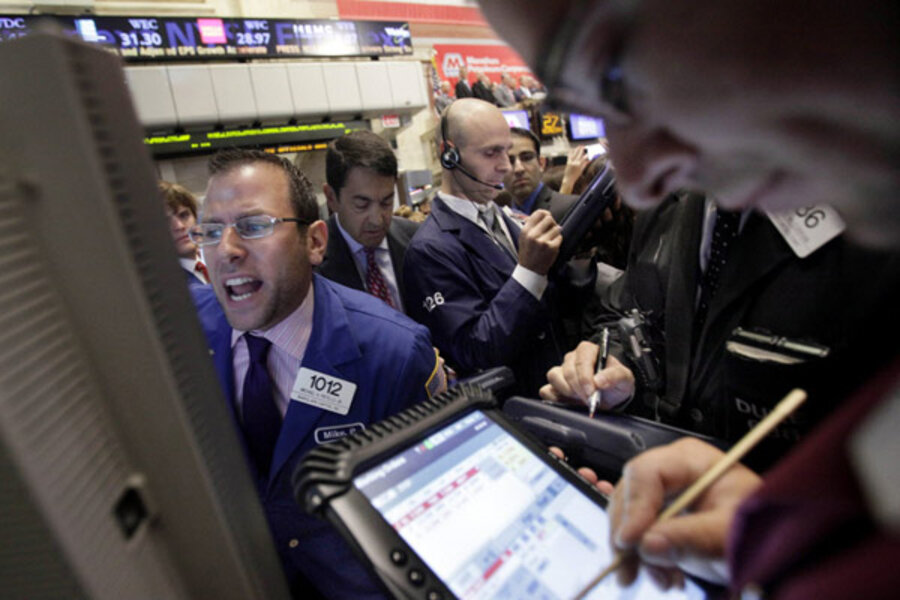Debt ceiling: How would investors react to a default?
Loading...
| New York
The debt-ceiling negotiations are now like a heavy weight hanging over the stock market. The Dow Jones Industrial Average fell 195.87 points Wednesday, which was the fourth consecutive loss.
As the Aug. 2 debt deadline approaches, investors can envision everything from the stock market dropping like a rock – perhaps as much as 20 percent – to the economy shrinking as government vendors lay off thousands of workers. In short, the worst that could happen.
However, none of that might happen. Perhaps politicians will suddenly find a solution, a way to cut the federal budget deficit and raise the debt ceiling at the same time. In short: a political compromise that helps portfolios. In that case, the stock market may recoup its losses, making this one of the better times to invest.
Here’s what some investors say are the best and worst things that could happen.
The best thing, says Mark Lamkin, CEO of Lamkin Wealth Management in Louisville, Ky., would be for Congress to agree on a $2 trillion, 10-year deal to reduce the budget deficit, combined with raising the debt ceiling.
“I don’t think we’re going to see a $4 trillion deal because the two sides are too far apart,” he says. Instead, the heavy lifting will fall to the next Congress, he says.
Why is this such a good deal? “It beats the heck out of a default,” says Mr. Lamkin.
Fred Dickson, chief investment strategist at D.A. Davidson & Co. in Lake Oswego, Ore., hopes the two parties reach an agreement just in time for the Sunday talk shows. “In that case, the markets would bounce up pretty sharply on Monday,” he says.
Mr. Dickson expects that if they can reduce the deficit by $1 trillion over 10 years, “it would be a reasonable starting point.”
The best-case scenario for Sam Stovall, chief investment strategist at Standard & Poor’s in New York, entails a far larger package – what he terms a “big-ticket agreement” that would reduce the budget deficit by $4 trillion over 10 years. In addition, Congress would agree to extend the debt limit so it does not need to be revisited next year “and used as a political football.”
Standard & Poor’s, commenting in the past on the possibility of a $4 trillion cut in the budget, has said a reduction that large would bring the US debt level within the range acceptable for a AAA-rated bond. Thus, the United States would keep its stellar rating.
On Wednesday at a congressional hearing, Deven Sharma, president of Standard & Poor’s, said the rating agency’s analysts don’t believe the US will default on its debt.
Of course, not all the outlooks are rosy. To Lamkin, the worst-case scenario is a very short-term arrangement that averts a default but does not appease the rating agencies. “The worst-case scenario is one where they make an 11-1/2-hour deal in which the basic things are paid for but they don’t solve anything,” he says.
Such a short-term agreement would probably lead to a ratings downgrade. Lamkin calls such a downgrade “a tax on every American.”
The government’s borrowing costs would go up, he estimates, between one-half and three-quarters of a percentage point. Since the US has about $14 trillion in debt, the extra interest costs would probably wipe out any budget savings passed by Congress, he says. In addition, the cost of borrowing to buy a house would rise. State and municipal governments could also see their borrowing costs rise.
In this worst-case scenario, the stock market could fall between 10 percent and 15 percent, Lamkin says. “You could see a drop of 1,200 points in consecutive days,” he warns. “It would really depend on how long the default went on.”
It’s possible, Mr. Stovall says, that the stock market would have a sharp sell-off in the event of a default. “Let’s face it, so many people don’t expect one, so it’s not built into the market’s pricing,” he says.
Mr. Dickson’s worst-case scenario is that the two sides cannot agree on even “an extra innings” extension of the debt ceiling, which would give them, say, an extra month to try to reach an agreement. If that were to happen, Dickson expects the stock market to fall about 5 percent and the yields on government bonds to rise about one-quarter of a percentage point.
Dickson hopes the two sides don’t postpone making hard decisions. “If they just try to avoid default without resolving the issues, then we have to go through this again six months or 12 months or 18 months from now,” he says.





